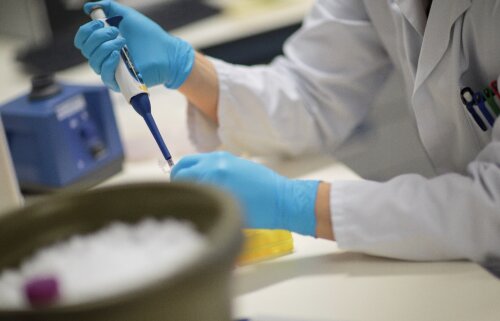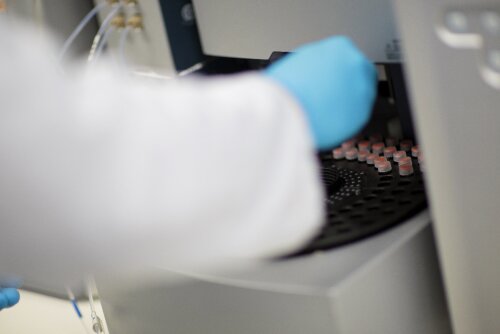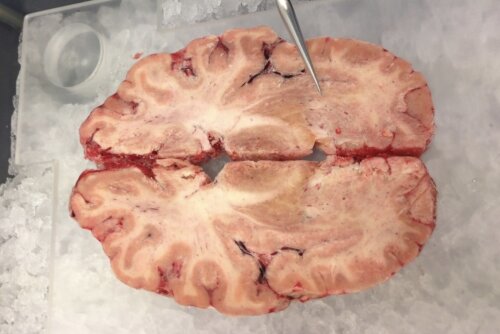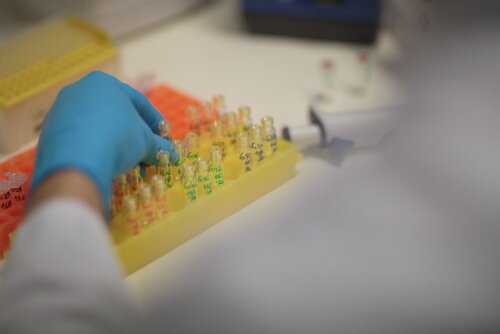The interdisciplinary team of the Neurochemistry and Behaviour group aims at the development of diagnostic and/or therapeutic measures for neurodegenerative disorders and the clarification of the complex underlying pathophysiological processes of a spectrum of neurological diseases, including Alzheimer's disease, Frontotemporal dementia, Parkinson's disease, Lewy body dementia, and amyotrophic lateral sclerosis. By dissecting the molecular cascades, genetic predispositions, and environmental factors contributing to disease onset and progression, we strive to uncover commonalities and divergences across these disorders.
Our multidisciplinary approach integrates cognitive and behavioral, neurochemical, histological and genetic investigations, leveraging diverse rodent models to mirror human pathology and advance translational relevance. This commitment to excellence in preclinical research, alongside translational efforts, underscores our dedication to bridging the gap between bench and bedside.
Specific research focus is given to the development and early diagnosis of Alzheimer’s disease in people with Down syndrome. Besides typical physical features and mild to moderate intellectual disabilities, people with Down syndrome (DS) face accelerated aging and are at extremely high risk to develop AD. In the general population, BPSD (behavioural and psychological symptoms) in AD patients are diagnosed using validated rating scales. However, no such scales are available for DS. Therefore, our team developed and validated a BPSD scale, named BPSD-DS that is specifically adapted for DS. Certain BPSD may be present already before the diagnosis of AD and related memory decline. Using this scale we will investigate if particular BPSD predict the development of AD in an early stage. The scale will also allow us to identify behavioural symptoms that are most burdensome (most severe) for the person with DS, and thus are key symptoms to treat in daily care. Concentrations in certain signalling molecules in the brain have been associated with BPSD. Building further on previous studies from our team, we will investigate whether these compounds can be measure in the blood and whether changes can predict that a person progresses to AD. Also the link with specific behavioural changes will be studied since this leads to better future treatments.
Ultimately, our mission is to contribute to the global effort in combating neurological disorders and enhancing brain health across the lifespan, and to pave the way for effective treatments and improve the lives of individuals affected by these devastating neurological disorders.
Selected publications
- Dekker AD, Ulgiati AM, Groen H, Boxelaar VA, Sacco S, Falquero S, Carfi A, di Paola A, Benejam B, Valldeneu S, Fopma R, Oosterik M, Hermelink M, Beugelsdijk G, Schippers M, Henstra H, Scholten-Kuiper M, Willink-Vos J, de Ruiter L, Willems L, Loonstra-de Jong A, Coppus AMW, Tollenaere M, Fortea J, Onder G, Rebillat AS, Van Dam D, De Deyn PP. The Behavioral and Psychological Symptoms of Dementia in Down Syndrome Scale (BPSD-DS II): Optimization and Further Validation. J Alzheimers Dis. 2021;81(4):1505-1527. doi: 10.3233/JAD-201427
- Dekker AD, Vermeiren Y, Albac C, Lana-Elola E, Watson-Scales S, Gibbins D, Aerts T, Van Dam D, Fisher EMC, Tybulewicz VLJ, Potier MC, De Deyn PP. Aging rather than aneuploidy affects monoamine neurotransmitters in brain regions of Down syndrome mouse models. Neurobiol Dis. 2017 Sep;105:235-244. doi: 10.1016/j.nbd.2017.06.007.
- Van Dam D, Vermeiren Y, Dekker AD, Naudé PJ, Deyn PP. Neuropsychiatric Disturbances in Alzheimer's Disease: What Have We Learned from Neuropathological Studies? Curr Alzheimer Res. 2016;13(10):1145-64. doi: 10.2174/1567205013666160502123607
- Heylen A, Vermeiren Y, Kema IP, van Faassen M, van der Ley C, Van Dam D, De Deyn PP. Brain Kynurenine Pathway Metabolite Levels May Reflect Extent of Neuroinflammation in ALS, FTD and Early Onset AD. Pharmaceuticals (Basel). 2023 Apr 19;16(4):615. doi: 10.3390/ph16040615.
- Solas M, Van Dam D, Janssens J, Ocariz U, Vermeiren Y, De Deyn PP, Ramirez MJ. 5-HT7 receptors in Alzheimer's disease. Neurochem Int. 2021 Nov;150:105185. doi: 10.1016/j.neuint.2021.105185.
- Van Erum J, Van Dam D, De Deyn PP. Alzheimer's disease: Neurotransmitters of the sleep-wake cycle. Neurosci Biobehav Rev. 2019 Oct;105:72-80. doi: 10.1016/j.neubiorev.2019.07.019.
Rodent Behavioural Research Unit
Behavioural phenotyping is crucially based upon test batteries of behavioural paradigms assessing different brain and behaviour functions. This type of research is often both laborious and time consuming and demands a specific know-how and sophisticated equipment.
The Rodent Behavioural Research Unit holds a strong expertise in the field of behavioural phenotyping of (transgenic) rodent models for human neurological and metabolic conditions.Behavioural changes are often linked to histological, electrophysiological or neurochemical correlates.
The Rodent Behavioural Research Unit also functions as a service facility for both internal and external research teams seeking in depth behavioural phenotyping of newly developed rodent models for neurological and metabolic conditions, as well as the cognitive and/or behavioural validation of various therapeutic interventions. Different routes are applied for the administration of (potentially) neuroactive substances, from simple (par)enteral administration, over the implantation of osmotic pumps, to cannulation for intracerebroventricular administration.
Expertise and Equipment
Behavioural observations range from the evaluation of simple reflexes to the systematic registration of complex learned responses.
Observational test batteries, like the Irwin primary screen or the SHIRPA primary screen, allow a systematized assessment of general health and reflexes.
Sensorimotor function assessment is applied to exclude potentially biasing sensory of motor impairments for other cognitive and/or behavioral tasks, or to assess sensory or motor impairment as one of the core symptoms in specific animal models. Motor performance, equilibrium and coordination are tested with an accelerating rotarod (Bioseb), the wire suspension test, the stationary beam test, and gait pattern analysis. Vision and olfaction are assessed with dedicated setups, like for example a visual cliff test and a novel odour test, and food tunnel test.
General activity and exploration levels are assessed in an open field arena complemented with a computerized video-tracking system (Ethovision system, Noldus). Latter tracking system is as well employed for recording of social interactive behaviour. Cage activity recording patterns of individually housed animals can be recorded over a period of several days by means of a computerized system.
Learning and memory performance can be evaluated in a variety of behavioural paradigms and designs, requiring distinct sensory and motor abilities, distinguishing explicit versus implicit memory, as well as short-term versus long-term memory. Passive avoidance learning is screened in a step-through box linked with a small animal shocker. The Morris water maze or Barnes maze combined with the Ethovision video-tracking system assesses hippocampal-dependent visual-spatial memory. Working memory is evaluated in a radial arm maze. Conditioning protocols are applied with Skinner or operant conditioning boxes (Coulbourn Instruments).
Fear responses are measured with a contextual fear protocol, as well as with an automated startle reflex system (Med Associates Inc). Anxiety can be quantified employing an elevated plus maze linked to the Ethovision video-tracking system, as well as a dark-light transition box and a holeboard.
The research unit has moreover ample experience in behavioural observations related to for example isolation-induced aggression, male sexual behaviour, depression-related symptoms, as well as the behavioural and electrophysiological study of epilepsy, and the sleep-wake cycle.
Selected publications
- Van Dam D, Valkenburg F, Van Kolen K, Pintelon I, Timmermans JP, De Deyn PP. Behavioral and Neuropathological Phenotyping of the Tau58/2 and Tau58/4 Transgenic Mouse Models for FTDP-17. Life (Basel). 2023 Oct 20;13(10):2088. doi: 10.3390/life13102088
- Hendrickx JO, Calus E, De Deyn PP, Van Dam D, De Meyer GRY. Short-Term Pharmacological Induction of Arterial Stiffness and Hypertension with Angiotensin II Does Not Affect Learning and Memory and Cerebral Amyloid Load in Two Murine Models of Alzheimer's Disease. Int J Mol Sci. 2022 Mar 1;23(5):2738. doi: 10.3390/ijms23052738
- Hendrickx JO, De Moudt S, Calus E, De Deyn PP, Van Dam D, De Meyer GRY. Long-Term Pharmacological Inhibition of the Activity of All NOS Isoforms Rather Than Genetic Knock-Out of Endothelial NOS Leads to Impaired Spatial Learning and Memory in C57BL/6 Mice. Biomedicines. 2021 Dec 14;9(12):1905. doi: 10.3390/biomedicines9121905
- Sorgdrager F, van Der Ley CP, van Faassen M, Calus E, Nollen EA, Kema IP, van Dam D, De Deyn PP. The Effect of Tryptophan 2,3-Dioxygenase Inhibition on Kynurenine Metabolism and Cognitive Function in the APP23 Mouse Model of Alzheimer's Disease. Int J Tryptophan Res. 2020 Dec 28;13:1178646920972657. doi: 10.1177/1178646920972657
- Van Erum J, Valkenburg F, Van Dam D, De Deyn PP. Pentylenetetrazole-induced Seizure Susceptibility in the Tau58/4 Transgenic Mouse Model of Tauopathy.Neuroscience. 2020 Jan 15;425:112-122. doi: 10.1016/j.neuroscience.2019.11.007
- Van Dam D, De Deyn PP. How does a researcher choose the best rodent model for their Alzheimer's disease drug discovery study? Expert Opin Drug Discov. 2020 Mar;15(3):269-271. doi: 10.1080/17460441.2020.1676719
- Van Erum J, Van Dam D, Sheorajpanday R, De Deyn PP. Sleep architecture changes in the APP23 mouse model manifest at onset of cognitive deficits. Behav Brain Res. 2019 Nov 5;373:112089. doi: 10.1016/j.bbr.2019.112089
- Van Erum J, Van Dam D, De Deyn PP. PTZ-induced seizures in mice require a revised Racine scale. Epilepsy Behav. 2019 Jun;95:51-55. doi: 10.1016/j.yebeh.2019.02.029.
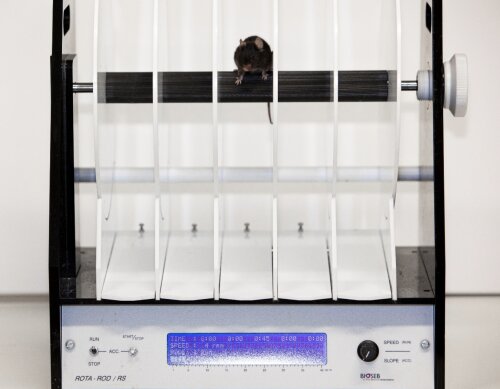

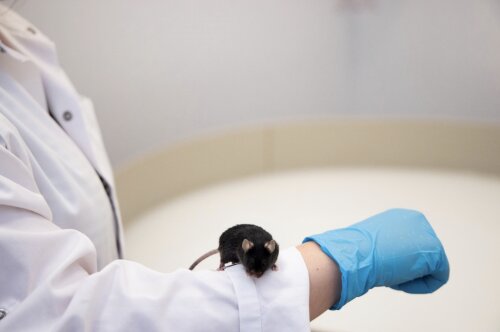
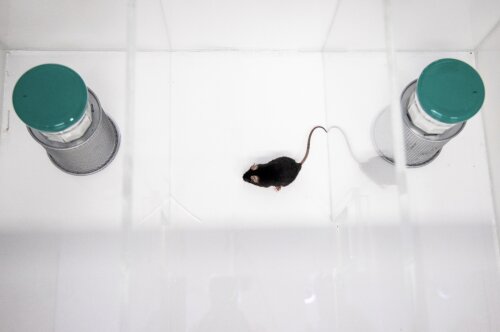
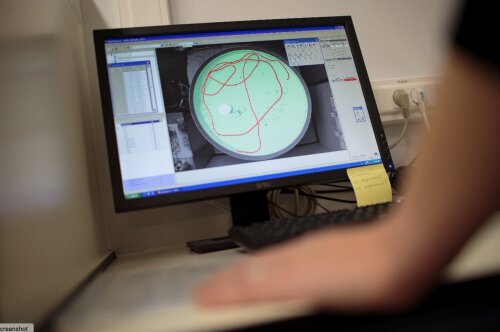
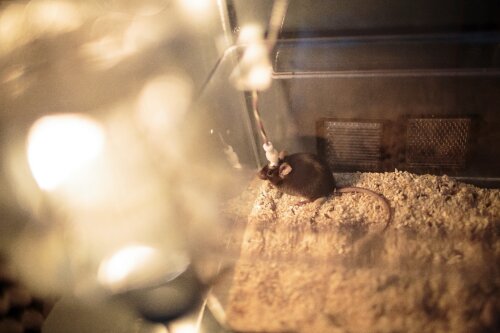
RP-HPLC Analytical Unit
Biogenic amines are low molecular mass organic bases mainly formed by decarboxylation of amino acids or by amination and transamination of aldehydes and ketones. They are commonly found in living organisms and play crucial roles in biological processes such as neurotransmission, cell signaling, and regulation of physiological functions.
The biogenic amines encompass multiple neurotransmitters, including serotonin, histamine, dopamine, norepinephrine, and epinephrine. The biogenic amine neurotransmitters regulate brain functions such as movement, behavior, emotions, temperature, blood pressure and endocrine secretion.
This research unit quantifies the biogenic amines, serotonin, dopamine, norepinephrine/noradrenaline, and epinephrine/adrenaline, as well as serotonergic (5-hydroxyindoleacetic acid, 5-HIAA), dopaminergic (3,4-dihydroxyphenylacetic acid, DOPAC; homovanillic acid, HVA) and norepinephrinergic (methoxy-4-hydroxyphenylglycol, MHPG) metabolites applying chromatic techniques.
RP-HPLC or Reverse Phase High Performance Liquid Chromatography, is a chromatographic technique used to separate and analyze compounds based on their hydrophobicity. It employs a non-polar stationary phase and a polar mobile phase, allowing molecules to elute based on their affinity for the stationary phase.
RP-UPLC or Reverse Phase Ultra Performance Liquid Chromatography, is an advanced form of liquid chromatography that shares similarities with traditional RP-HPLC, but offers enhanced performance and efficiency. It utilizes smaller particle sizes in the stationary phase and higher pressures in the system, compared to conventional HPLC. This results in even faster separations, higher resolution, and increased sensitivity,-.
Overall, RP-HPLC and RP-UPLC are interesting analytical techniques because of their:
- Wide Applicability: both techniques are applicable to a broad range of compounds, from small molecules to large biomolecules like proteins and peptides.
- High Sensitivity: They offers high sensitivity, allowing for the detection and quantification of compounds present in low concentrations.
- Excellent Resolution: They provides excellent resolution, enabling the separation of complex mixtures into individual components with high precision.
- Speed and Efficiency: These are a rapid technique, allowing for quick analysis of samples, which enhances productivity in laboratories.
- Quantitative Accuracy: They allow for accurate quantification of analytes, making it suitable for both qualitative and quantitative analysis in research and quality control settings.
- Versatility: Both techniques can be easily coupled with various detectors such as UV-Vis, fluorescence, and mass spectrometry, enhancing its versatility for different analytical needs.
Equipment
This research unit is fully equipped with one optimized Alexysä Dual Monoamines Analyzer with electrochemical detection (Antec Leyden BV, Zoeterwoude, The Netherlands). This device comprises two LC110 pumps, operating at an isocratic flow rate of 40µL/min. Samples (5 µL) are loaded with an AlexysTM AS 100 Autosampler on microbore ALF-125 columns (250 mm × 1 mm, C18, 3 µm particle size) maintained at a constant temperature of 36°C. The Decade II electrochemical detector is equipped with thin layered electrochemical VT03 flow cells each fitted with a glassy carbon 0.7 mm working electrode and an in situ Ag/AgCl (ISAAC) reference electrode. Integration of chromatograms (41 minutes runtime) is performed with channel integration M018/EN25B Clarity software (DataApex Ltd., Prague,The Czech Republic).
A second Alexys Neurotransmitter Analysis device is constructed as a RP-UPLC setting, using one LC110S pump delivering backpressures up to 700 bar. Separation is achieved by using a short 15cm Waters Acquity Column (BEH C18, 1 mm diameter, particle size 1.7 µm), delivering optimal performances for monoamine analysis. Total runtime for each sample is under 15 minutes after which all 8 monoamines and metabolites are detected.
Both devices can be (relatively easy) adapted or customized for analyses of other neurochemical compounds, such as GABA, glutamate, acetylcholine/choline, glutathione and nitrotyrosine.
Sample types and preparation
- Cerebrospinal fluid
- Serum
- Plasma
- Brain tissue
- Spinal cord tissue
- Urine
of animal or human origin are analyzed after fast and simple sample preparation protocols.
Selected publications
- Privitera M, von Ziegler LM, Floriou-Servou A, Duss SN, Zhang R, Waag R, Leimbacher S, Sturman O, Roessler FK, Heylen A, Vermeiren Y, Van Dam D, De Deyn PP, Germain PL, Bohacek J. Noradrenaline release from the locus coeruleus shapes stress-induced hippocampal gene expression. Elife. 2024 Mar 13;12:RP88559. doi: 10.7554/eLife.88559.
- Heylen A, Vermeiren Y, Kema IP, van Faassen M, van der Ley C, Van Dam D, De Deyn PP. Brain Kynurenine Pathway Metabolite Levels May Reflect Extent of Neuroinflammation in ALS, FTD and Early Onset AD. Pharmaceuticals (Basel). 2023 Apr 19;16(4):615. doi: 10.3390/ph16040615.
- Heylen A, Vermeiren Y, De Rooij SE, Scholtens RM, Van Munster BC, Van Dam D, De Deyn PP. Plasma 5-HIAA activity indicative of serotonergic disturbances in cognitively impaired, elderly patients experiencing postoperative delirium. Int J Geriatr Psychiatry. 2022 Feb;37(2):10.1002/gps.5677. doi: 10.1002/gps.5677.
- Janssens J, Vermeiren Y, Fransen E, Aerts T, Van Dam D, Engelborghs S, De Deyn PP. Cerebrospinal fluid and serum MHPG improve Alzheimer's disease versus dementia with Lewy bodies differential diagnosis. Alzheimers Dement (Amst). 2018 Feb 6;10:172-181. doi: 10.1016/j.dadm.2018.01.002.
- van der Zee S, Vermeiren Y, Fransen E, Van Dam D, Aerts T, Gerritsen MJ, Spikman JM, van Laar T, De Deyn PP. Monoaminergic Markers Across the Cognitive Spectrum of Lewy Body Disease. J Parkinsons Dis. 2018;8(1):71-84. doi: 10.3233/JPD-171228.
- Dekker AD, Vermeiren Y, Albac C, Lana-Elola E, Watson-Scales S, Gibbins D, Aerts T, Van Dam D, Fisher EMC, Tybulewicz VLJ, Potier MC, De Deyn PP. Aging rather than aneuploidy affects monoamine neurotransmitters in brain regions of Down syndrome mouse models. Neurobiol Dis. 2017 Sep;105:235-244. doi: 0.1016/j.nbd.2017.06.007.
- Dekker AD, Coppus AM, Vermeiren Y, Aerts T, van Duijn CM, Kremer BP, Naudé PJ, Van Dam D, De Deyn PP. Serum MHPG strongly predicts conversion to Alzheimer's disease in behaviorally characterized subjects with Down syndrome. J Alzheimers Dis. 2015;43(3):871-91. doi: 10.3233/JAD-140783.
- Van Dam D, Vermeiren Y, Aerts T, De Deyn PP. Novel and sensitive reversed-phase high-pressure liquid chromatography method with electrochemical detection for the simultaneous and fast determination of eight biogenic amines and metabolites in human brain tissue. J Chromatogr A. 2014 Aug 1;1353:28-39. doi: 10.1016/j.chroma.2014.05.004.
- Vermeiren Y, Van Dam D, Aerts T, Engelborghs S, Martin JJ, De Deyn PP. The monoaminergic footprint of depression and psychosis in dementia with Lewy bodies compared to Alzheimer's disease. Alzheimers Res Ther. 2015 Feb 11;7(1):7. doi: 10.1186/s13195-014-0090-1.
